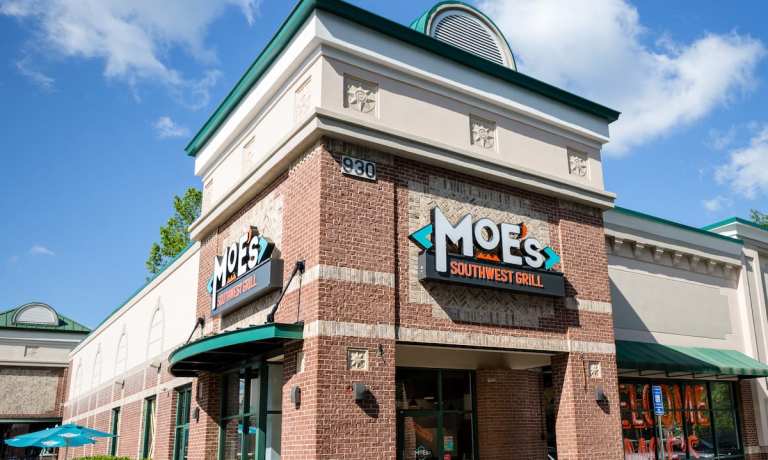
With the majority of U.S. adults vaccinated and with life beginning to settle down for businesses and consumers, many are taking stock of the lessons of the past year and a half. For individuals, this may mean taking a yoga class or reaching out to an old friend. For restaurants, it means finding ways to integrate the digital ordering boom occasioned by the pandemic into their post-COVID operations. While digital ordering channels can be an additional option tacked onto a restaurant’s existing model, leading brands are finding ways to make the highly in-demand channel central to their business.
For Moe’s Southwest Grill, the Atlanta-based fast-casual chain with over 700 locations, this has meant modernizing restaurants both aesthetically and technologically, with the new look signaling to consumers that the brand is evolving for the 2020s. The company announced earlier this month that, after successfully updating restaurants in Nashville, Tennessee; Charleston, South Carolina; and Rochester, New York, the company is now doing the same for its restaurants in the Atlanta area.
“The modernization piece plays a huge role, because you can’t be the last man standing on the block that is not modernized, not convenient and not relevant, because you’ll get overlooked pretty quickly,” Alex Williams, chief brand officer at Moe’s, told PYMNTS in an interview. “It’s very noticeable in areas where there are high levels of modernization, and so you’ve got to make sure that you have those elements of convenience as well as accessibility.”
The Drive-Thru Boost
One of the most important channels for major restaurant chains right now is the drive-thru. Brands that have never before offered the channel are opening new drive-thru locations, and restaurants that have always relied on the channel are looking to take it into the future with new digital integrations.
“The ability to add a drive-thru in our new prototype will be essential,” said Williams, noting that of the chain’s 14 new locations throughout the country this year, 11 will be drive-thrus. “The convenience factor, as well as the accessibility factor, plays a critical role in people being able to use the brand how they’d like to use it.”
Many consumers adopted the ordering method during the pandemic, with one survey from the start of 2021 finding that nearly three-quarters of U.S. consumers had used a drive-thru since the start of the pandemic, a 43 percent rise since April 2020. Additionally, research highlighted by PYMNTS’ October Order to Eat Tracker®, created in collaboration with Paytronix, found that drive-thru trips grew by 26 percent in Q2 2020 to make up 42 percent of all restaurant visits.
In addition to adding drive-thru locations, Moe’s has also added an “I’m here” button to its app for curbside pickup orders, streamlining the collection process for mobile order-ahead. Williams noted that these improved order collection methods “will be a big part of trying to make this design a little more seamless.”
The Right Tool For The Job
While virtually all restaurants can benefit from making their online ordering platforms more accessible and easier to use, different kinds of orders require different user experiences. A large part of Moe’s sales — and one that took a significant hit during quarantine but is recovering with the vaccine rollout — is its catering business.
Of course, a platform designed to make it easy for consumers to customize their individual taco orders will not also be the best way to order catering for their corporate functions. Moe’s has designed its mobile app with the former in mind and its desktop site with the latter.
“The [desktop] web application will probably be good for people who are ordering lunch for big catering orders or for particular events,” said Williams. “That’ll be a different occasion than [an individual] ordering lunch … or people who are going to lunch.”
While digital ordering for individual meals has exploded since the start of the pandemic, with consumers quickly growing accustomed to the ease and convenience and adjusting their expectations accordingly, catering orders are only starting to catch up. After all, most people were not holding large gatherings during the most severe months of the pandemic, meaning that catering has been largely left out of the digital shift.
Judging A Book By Its Cover
Citing the examples of Moe’s Rochester and Nashville locations, Williams noted that before changing the look of its restaurants, operators changed restaurants’ internal operations, implementing these new ordering improvements as well as changing standards for food preparation and hospitality.
However, the lack of aesthetic changes obscured these improvements for consumers. Now, after updating restaurants with a new logo, new signage, new paint job and more, restaurants have made their changes more visible. In response to these changes, Williams said, customers “gave us credit by coming back again,” leading to increased sales and guest count growth in these Nashville and Rochester locations.
“The first thing that happened was, [customers] noticed that something was different,” said Williams. “So then when they ordered curbside and/or delivery, they would say, ‘Wow … that’s not the same Moe’s.’”